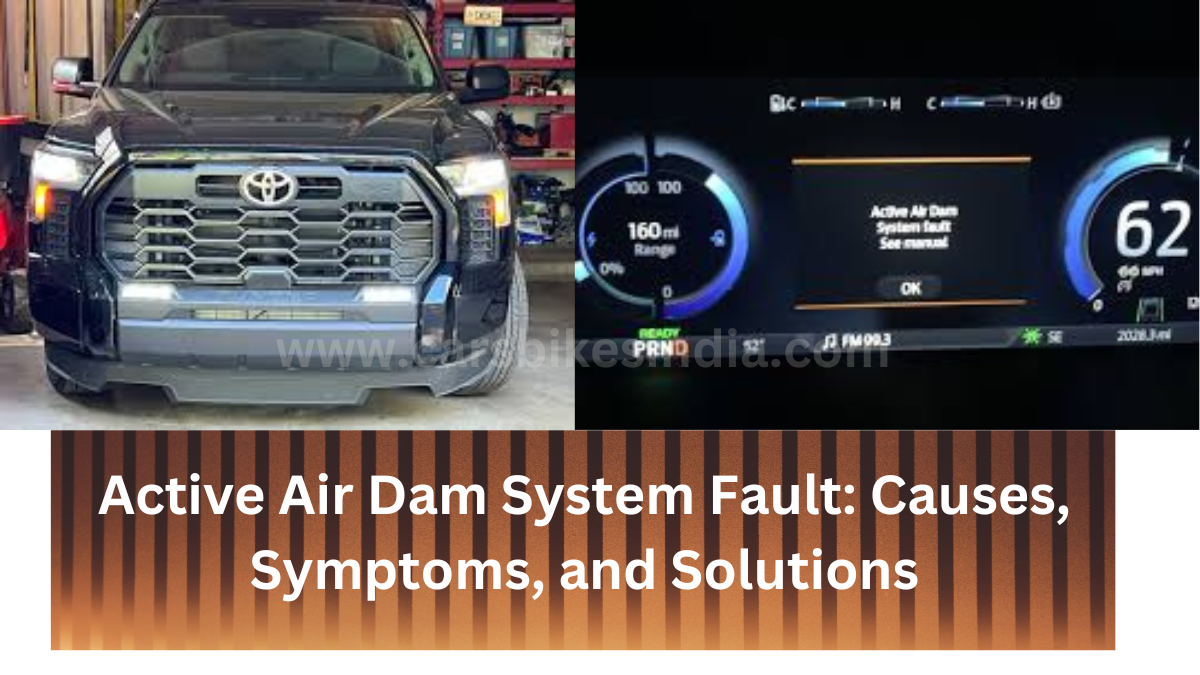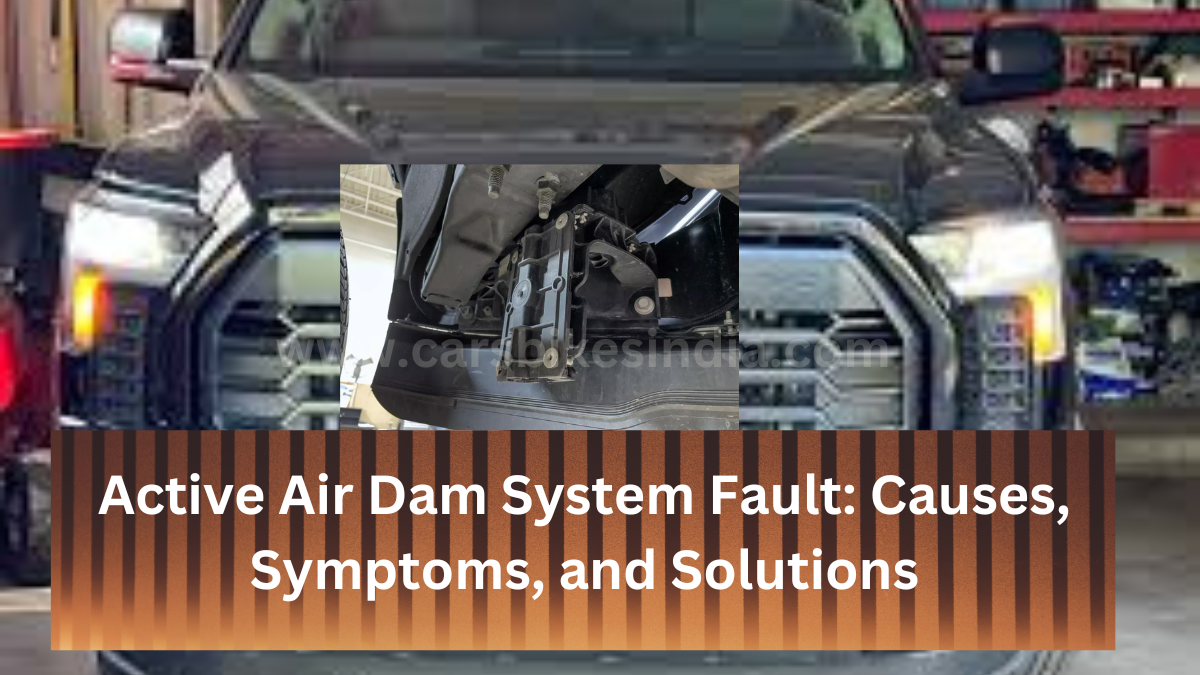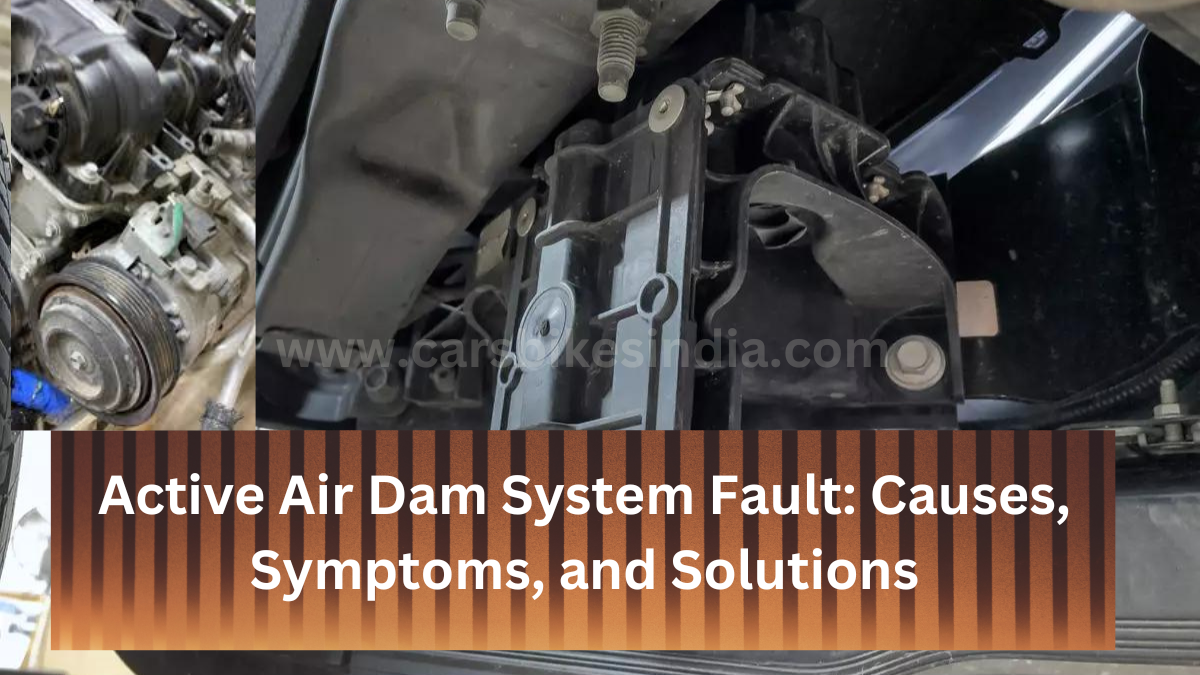Active Air Dam System Fault: Modern vehicles come with a wide array of advanced technologies designed to improve aerodynamics, fuel efficiency, and overall performance. One such innovation is the active air dam system. This system is particularly common in trucks, SUVs, and other vehicles that benefit from enhanced fuel efficiency and reduced drag. However, like any mechanical or electronic component, it’s not immune to issues. When the vehicle displays a message indicating an “Active Air Dam System Fault,” it means there’s an issue with this system that needs attention.

In this detailed article, we’ll explore what the active air dam system is, how it works, common causes of system faults, and what to do when such a fault occurs.
What is an Active Air Dam System?
The active air dam system is a feature found in many modern vehicles designed to improve aerodynamic efficiency. An air dam is a component located at the front of a vehicle, often just beneath the bumper. Its primary function is to direct airflow around the vehicle in a way that reduces drag and enhances fuel efficiency. While traditional air dams are fixed components, active air dams are dynamic and can move depending on driving conditions.
How the Active Air Dam System Works:
- Deployment: At certain speeds, usually above 35 mph, the active air dam automatically lowers or extends to reduce aerodynamic drag. This helps the vehicle achieve better fuel economy, especially at highway speeds.
- Retraction: When the vehicle slows down or comes to a stop, the system retracts the air dam back into the vehicle’s body to prevent damage from road obstacles like curbs, rocks, or parking bumps. It also retracts when driving at low speeds, where aerodynamic efficiency is less critical.
- Sensors and Control: The active air dam system is controlled by the vehicle’s electronic control unit (ECU) and sensors that monitor speed, driving conditions, and external factors like temperature. It adjusts the position of the air dam automatically without requiring driver input.
What Does an “Active Air Dam System Fault” Mean?
When a vehicle’s onboard diagnostic system detects an issue with the active air dam system, it will trigger an error message or warning light on the dashboard, often labeled as “Active Air Dam System Fault.” This indicates that the system is not functioning properly and may not be able to deploy or retract as intended.

Active Air Dam System Fault: This fault can affect the vehicle’s aerodynamic performance, potentially reducing fuel efficiency. However, it’s important to note that an active air dam system fault typically does not compromise the vehicle’s safety or drivability. Nevertheless, it’s advisable to address the issue promptly to ensure optimal performance and fuel economy.
Common Causes of an Active Air Dam System Fault
There are several reasons why an active air dam system might fail or experience issues. These causes can be mechanical, electrical, or sensor-related. Below are some of the most common reasons for an active air dam system fault:
1. Physical Obstructions or Damage
- Debris or Road Obstructions: The air dam system is positioned low on the vehicle, making it susceptible to damage from debris, rocks, or road hazards. If something is lodged in the system or damages the mechanism, it may trigger a fault.
- Impact Damage: Hitting curbs, parking barriers, or other obstacles while parking or driving at low speeds can physically damage the air dam or its components, preventing it from moving correctly.
2. Sensor Malfunction
- Faulty Sensors: The active air dam relies on sensors to determine when it should deploy or retract. If these sensors fail or malfunction, the system may not receive the correct signals, causing a fault.
- Communication Issues: The sensors communicate with the vehicle’s ECU. A disruption in this communication due to faulty wiring or sensor connections can trigger the system fault.
3. Electrical Issues
- Blown Fuses: The active air dam system is powered by the vehicle’s electrical system. A blown fuse can prevent the system from functioning, leading to a fault warning.
- Faulty Actuators: The movement of the air dam is controlled by actuators. If these actuators fail, the air dam may not be able to extend or retract properly, triggering a system fault.
4. Software Glitches
- Control Module Errors: The ECU or the specific control module that manages the active air dam system can sometimes encounter software bugs or glitches. These errors can cause the system to misbehave, even if the hardware is functioning properly.
- Outdated Software: In some cases, the active air dam system may require a software update to fix bugs or improve performance. If the software is outdated, it can result in operational issues.
5. Extreme Weather Conditions
- Cold Weather: In colder climates, ice or snow can build up around the air dam, causing it to get stuck or malfunction. If the system is unable to move freely due to ice or snow, it will trigger a fault.
- Hot Weather: Excessive heat can sometimes cause components to expand or malfunction, leading to similar issues.
Diagnosing and Fixing an Active Air Dam System Fault
If your vehicle displays an active air dam system fault, it’s important to diagnose and fix the issue as soon as possible to restore optimal performance. Below are the steps you can take:
1. Check for Obstructions
The first step is to physically inspect the air dam and surrounding area for any debris or visible damage. If there’s something stuck in the system, carefully remove it. Avoid using force, as it may damage the mechanism further.

2. Inspect Sensors and Connections
If the system appears physically intact, the next step is to check the sensors. Look for any signs of dirt, damage, or loose connections that could interfere with their operation. Cleaning or reconnecting the sensors might resolve the issue.
3. Check Electrical Components
Inspect the vehicle’s fuses related to the active air dam system. If a fuse is blown, replace it with a fuse of the correct amperage. If the problem persists, it may indicate a deeper electrical issue, such as faulty wiring or malfunctioning actuators.
4. Perform a Diagnostic Scan
Using an OBD-II scanner, you can retrieve error codes related to the active air dam system. These codes can give you more specific information about the fault and help pinpoint the exact cause of the issue.
5. Software Updates
If the system fault is software-related, your dealership or a qualified mechanic can update the vehicle’s software to the latest version. This is especially important if the manufacturer has issued a recall or service bulletin regarding the active air dam system.
6. Consult a Professional
If you’re unable to resolve the issue on your own, it’s recommended to take your vehicle to a certified mechanic or dealership. They have the tools and expertise to diagnose and repair more complex issues with the active air dam system.
Preventing Active Air Dam System Faults
To avoid encountering an active air dam system fault in the future, there are some preventative measures you can take:
- Drive Carefully on Rough Terrain: Since the air dam is positioned low on the vehicle, it’s more susceptible to damage. Be cautious when driving over speed bumps, curbs, or rocky terrain to avoid impact damage.
- Regular Maintenance: Ensure that your vehicle’s sensors and electrical systems are regularly checked during routine maintenance. Keeping the air dam and its components clean and free of debris can also prevent issues.
- Monitor Weather Conditions: In extreme weather, inspect the air dam for ice, snow, or excessive dirt buildup that could cause it to malfunction.
Conclusion
An “Active Air Dam System Fault” is typically not a critical issue, but it does affect the vehicle’s aerodynamics and, subsequently, its fuel efficiency. Understanding the common causes, from sensor malfunctions to physical damage, can help you diagnose and resolve the issue. While some fixes may be as simple as clearing debris or replacing a fuse, more complex problems might require professional attention.
By taking care of your vehicle’s active air dam system and addressing faults promptly, you can ensure optimal performance, improve fuel efficiency, and extend the lifespan of your vehicle’s components.


